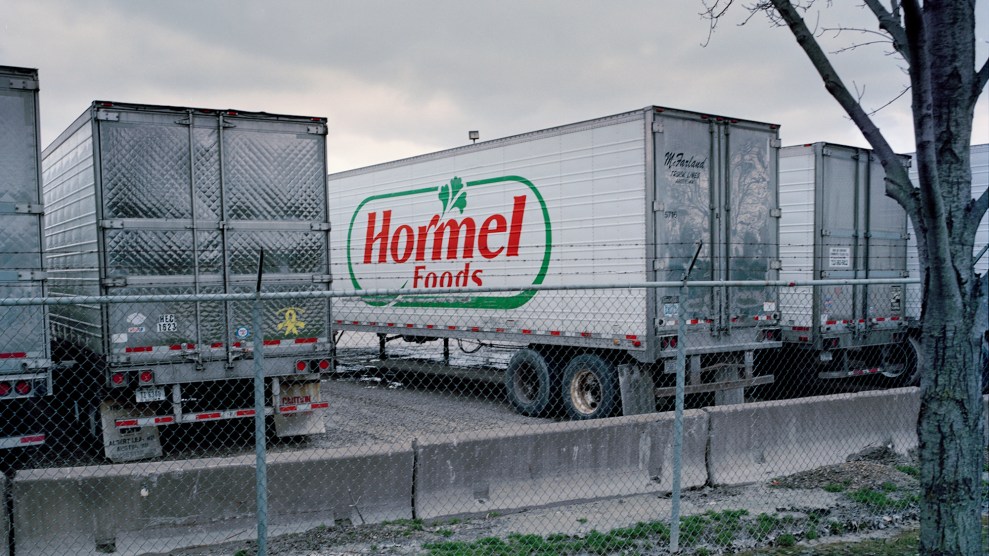
AP Photo/Danny Johnston
Workers have filed dozens of lawsuits against Tyson Foods alleging millions of dollars in “wage theft” for its failure to keep wage and hour records and to properly pay workers for overtime as required by the Fair Labor Standards Act (FLSA). On Tuesday, Tyson came before the US Supreme Court and argued that the justices should make those lawsuits go away. Tyson Foods v. Bouaphakeo is truly a David-versus-Goliath lawsuit, with about 3,000 low-income, often immigrant workers going up against the world’s second-largest meat processor, which has more than $30 billion in annual sales.
Tyson has asked the nation’s highest court to throw out a lawsuit that resulted in a $6 million jury verdict against the company in Iowa for cheating its workers out of earned overtime. Tyson doesn’t just want the case thrown out, though. The verdict at issue amounts to peanuts for the multinational corporation—a little more than two hours’ worth of Tyson’s annual profits. The company also wants the court to issue a broad ruling that would effectively immunize it against future class actions for wage and hour theft, and make it much harder for workers everywhere to join together to bring such claims. If it wins this case, Tyson could have it both ways: It could effectively continue to violate the FLSA and escape liability for it in court.
Tyson is one of three significant legal assaults on class actions before the court this term, waged by big businesses seeking to make it more difficult for workers and consumers to join together to sue them for misconduct. Weighing in on Tyson’s side in the case are other corporate giants, including Wal-Mart, Dow Chemical, the US Chamber of Commerce, and the National Association of Manufacturers.
The case hinges on a technical issue over whether plaintiffs in an FLSA case can use statistical averaging to calculate lost wages in the absence of good time records. Workers at the Storm Lake pork processing plant must wear sanitary and safety equipment such as hard hats, belly guards, and earplugs on the processing line and in the slaughterhouse. Putting this equipment on and off takes time, as does walking to the processing line, and that’s time that should be included, by law, in workers’ pay, including overtime.
Instead of simply having workers punch a time clock when they got to work and started donning their gear, for many years the company paid them through a controversial approach known as the “gang system.” Workers were paid for a 40-hour week starting at the exact moment when they got to the processing line and a product arrived at the work station, not when they started putting on their gear.
In 1988, the US Department of Labor sued Tyson over the gang system on the grounds that it violated the FLSA requirement for record-keeping and overtime. After eight years of litigation, in 1996, a federal court issued an injunction against the company for violating the FLSA’s record-keeping provisions by refusing to track the time workers spent donning and doffing gear, and paying them for it.
In response, instead of deploying a well-placed time clock that would accurately record how much time workers spent on the job, Tyson conducted an industrial study to come up with an average time workers spent getting ready for work—a unit of time they referred to as “K time”—and it used those averages to pay its workers. In the Iowa plant, “K time” worked out to be about four minutes a shift, plus a couple more for walking to and from the plant. Tyson still didn’t keep records of the actual time workers spent donning their safety gear, and workers continued to sue. (In 2000, the US Department of Labor sued the company again, over the same issues, on behalf of workers in Alabama, and in 2009, a court found the company in violation of the FLSA once again.)
The Iowa workers sued Tyson over this system in 2007, arguing that the time spent changing in and out of safety gear was far greater than four minutes. Their lawyers hired an expert to conduct a statistical study of the time workers spent changing and walking to the processing line. That expert watched more than 740 different video clips of workers going to and fro in the plant and putting on hard hats and other safety gear and concluded the average changing time was roughly 18 minutes or 21 minutes, depending on the type of work involved.
Using those measurements, the plaintiffs estimated that some workers lost less than $50 in wages during the period covered by the suit. But for others, according to Scott Michelman, a lawyer from the Public Citizen Litigation Group representing the workers, the lost pay was upwards of $9,000. In all, after a nine-day trial, a jury concluded in 2011 that between 2004 and 2010, Tyson had stiffed workers nearly $3 million in wages under this system. The jury added additional damages to the award, bringing the total to nearly $6 million.
Tyson appealed, arguing among other things that the lawsuit should never have been allowed to proceed as a class action. The company said the workers should never have been treated as similarly situated, because every worker’s donning and doffing speed was different. To support its argument, Tyson relied on the court’s 2011 ruling in a huge class action against Wal-Mart that potentially involved more than 1 million women who alleged systemic gender discrimination working for the retail giant. In a controversial 5-4 ruling, the court sided with Wal-Mart and threw out the women’s case, which could have resulted in as much as $11 billion in damages against Wal-Mart. The court said each woman had individual circumstances that couldn’t be adjudicated in a group lawsuit, decried the “trial by formula,” and ruled that class actions could only include people who had narrowly focused and similar situations. That case has made discrimination and other employment cases much harder to bring as class actions.
Tyson relied heavily on this precedent to argue that each worker in Iowa should have to file suit individually and have his or her losses calculated one at a time, rather than through a statistical study that averaged thousands of workers together. The problem with that argument is that Tyson used nearly the same sort of statistical averaging when it came up with the payment scheme for workers at the Iowa plant, a fact that wasn’t lost on the Supreme Court justices Tuesday.
At one point, Justice Sonia Sotomayor interrupted Tyson lawyer Carter G. Phillips, throwing up her hands at his insistence that the plaintiffs’ statistical study was inappropriate. “Mr. Phillips, I’m completely at a loss as to what you’re complaining about,” she said. She noted that Tyson didn’t seem to have a problem using a statistical study to calculate its own compensation system. “That’s exactly what you did. [Y]our expert that you used to calculate ‘gang time’ and ‘K-time’ did exactly the same thing [the plaintiffs’] expert did…At least their expert used hundreds of people instead of the few that you did. I’m just completely at a loss.”
Also problematic for Tyson is the fact that the statistical study itself would not have been necessary had Tyson not broken federal law by refusing to keep accurate records of employees’ work time in the first place. Indeed, in a similar case, an appeals court observed that Tyson “could have avoided litigation by simply paying and recording actual time for donning and doffing.” A long-established Supreme Court precedent, stemming from a 1946 decision in Anderson v. Mt. Clemens Pottery Co., says that in wage and hour cases, when an employer fails to keep time records, statistical averaging is a perfectly fine method of proving how much employees worked, and as a result, courts have accepted statistical averaging in these cases for decades. Tyson now wants the Supreme Court to toss all that precedent out the window.
Judging from the arguments Tuesday, it’s still far cheaper in the long run for Tyson to continue fending off a few lawsuits than it is to comply with the recordkeeping law and pay workers accordingly. Phillips told the court that a difference of a mere three minutes of changing time per worker translated into $1.4 million less in damages in the case. That may explain why, as one Tennessee federal court observed in 2008, Tyson has “now been litigating this same issue for decades, reflecting what can only be described as a deeply-entrenched resistance to changing their compensation practices to comply with the requirements of [the] FLSA.”
The justices were sharply critical of Tyson’s arguments, particularly crucial swing voter Justice Anthony Kennedy who, right out of the gate, said to Phillips, “I just don’t understand your argument.” While the case has ideological overtones, the justices quizzed Phillips relentlessly on Tyson’s trial strategy, which seemed to have been to focus on the Wal-Mart decision as precedent to get the case thrown out rather than vigorously defending the lawsuit before the jury. Assistant Solicitor General Elizabeth Prelogar, arguing for the government on the side of the workers, gave a rapid-fire laundry list of all the ways Tyson’s poor trial strategy produced the verdict it was now asking the court to overturn. She said that those trial failures were the problem with this case, not any flaw in the class action mechanism. Some of the justices seemed to agree, particularly Kennedy.
This case is a classic example of why these sorts of collective legal actions are so crucial in enforcing the nation’s employment and consumer protection laws. Workers can’t depend on the government to enforce the labor laws. As Prelogar noted in answering a question from Justice Ruth Bader Ginsburg, the secretary of labor “has limited resources and can’t conduct enforcement actions for every violation of the FLSA.” And if every individual worker screwed out of overtime pay at Tyson’s Iowa plant had to file a separate lawsuit, no lawsuits would ever get filed, and the practice would persist because no lawyer would take a case with such a low dollar value. As Public Citizen’s Michelman said in an interview, quoting a famous class action decision, “Only a lunatic or fanatic would sue for $30.”
















